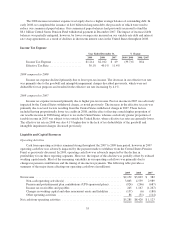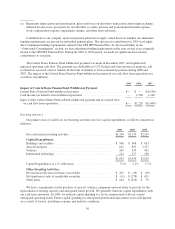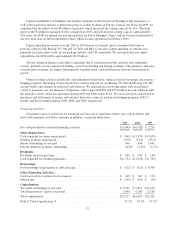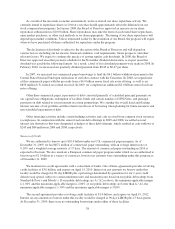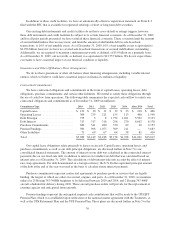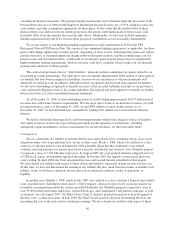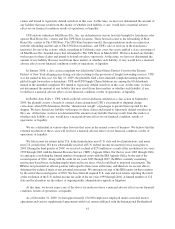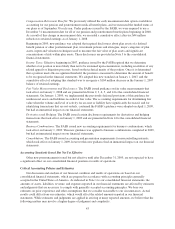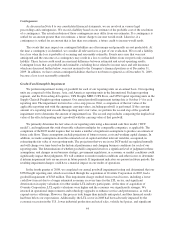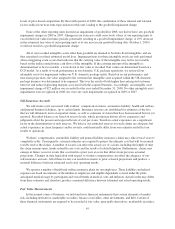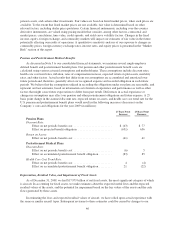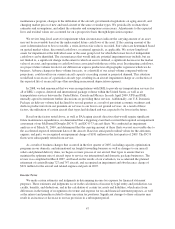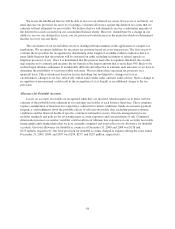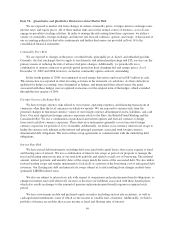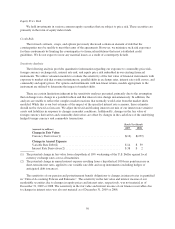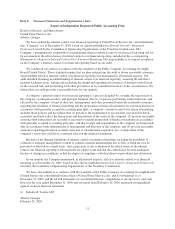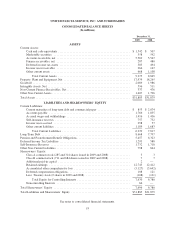UPS 2009 Annual Report Download - page 56
Download and view the complete annual report
Please find page 56 of the 2009 UPS annual report below. You can navigate through the pages in the report by either clicking on the pages listed below, or by using the keyword search tool below to find specific information within the annual report.Contingencies
As discussed in Note 8 to our consolidated financial statements, we are involved in various legal
proceedings and contingencies. We record a liability based on our estimate of the probable cost of the resolution
of a contingency. The actual resolution of these contingencies may differ from our estimates. If a contingency is
settled for an amount greater than our estimate, a future charge to income would result. Likewise, if a
contingency is settled for an amount that is less than our estimate, a future credit to income would result.
The events that may impact our contingent liabilities are often unique and generally are not predictable. At
the time a contingency is identified, we consider all relevant facts as part of our evaluation. We record a liability
for a loss when the loss is probable of occurring and reasonably estimable. Events may arise that were not
anticipated and the outcome of a contingency may result in a loss to us that differs from our previously estimated
liability. These factors could result in a material difference between estimated and actual operating results.
Contingent losses that are probable and estimable, excluding those related to income taxes and self insurance
which are discussed further below, were not material to the Company’s financial position as of December 31,
2009. In addition, we have certain contingent liabilities that have not been recognized as of December 31, 2009,
because a loss is not reasonably estimable.
Goodwill and Intangible Impairment
We perform impairment testing of goodwill for each of our reporting units on an annual basis. Our reporting
units are comprised of the Europe, Asia, and Americas reporting units in the International Package reporting
segment, and the Forwarding & Logistics, UPS Freight, MBE / UPS Store, and UPS Capital reporting units in the
Supply Chain & Freight reporting segment. Our annual goodwill impairment testing date is October 1st for each
reporting unit. The impairment test involves a two-step process. First, a comparison of the fair value of the
applicable reporting unit with the aggregate carrying values, including goodwill, is performed. If the carrying
amount of a reporting unit exceeds the reporting unit’s fair value, we perform the second step of the goodwill
impairment test to determine the amount of impairment loss. The second step includes comparing the implied fair
value of the affected reporting unit’s goodwill with the carrying value of that goodwill.
We primarily determine the fair value of our reporting units using a discounted cash flow model (“DCF
model”), and supplement this with observable valuation multiples for comparable companies, as applicable. The
completion of the DCF model requires that we make a number of significant assumptions to produce an estimate of
future cash flows. These assumptions include projections of future revenue, costs and working capital changes. In
addition, we make assumptions about the estimated cost of capital and other relevant variables, as required, in
estimating the fair value of our reporting units. The projections that we use in our DCF model are updated annually
and will change over time based on the historical performance and changing business conditions for each of our
reporting units. The determination of whether goodwill is impaired involves a significant level of judgment in these
assumptions, and changes in our business strategy, government regulations, or economic or market conditions could
significantly impact these judgments. We will continue to monitor market conditions and other factors to determine
if interim impairment tests are necessary in future periods. If impairment indicators are present in future periods, the
resulting impairment charges could have a material impact on our results of operations.
In the fourth quarter of 2008, we completed our annual goodwill impairment testing and determined that our
UPS Freight reporting unit, which was formed through the acquisition of Overnite Corporation in 2005, had a
goodwill impairment of $548 million. This impairment charge resulted from several factors, including a lower
cash flow forecast due to a longer estimated economic recovery time for the LTL sector, and significant
deterioration in equity valuations for other similar LTL industry participants. At the time of acquisition of
Overnite Corporation, LTL equity valuations were higher and the economy was significantly stronger. We
invested in operational improvements and technology upgrades to enhance service and performance, as well as
expand service offerings. However, this process took longer than initially anticipated, and thus financial results
had been below our expectations. Additionally, the LTL sector in 2008 had been adversely impacted by the
economic recession in the U.S., lower industrial production and retail sales, volatile fuel prices, and significant
44



